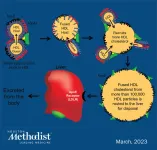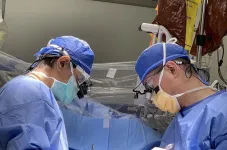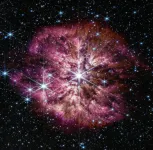(Press-News.org) Houston Methodist scientists reversed infertility in sterile mice by reducing high-circulating cholesterol with a bacterial protein, showing further evidence that links high cholesterol to female infertility. This is a promising development, with one in every five women of childbearing age in the U.S. unable to get pregnant after trying for a year.
“We are working with a protein, called serum opacity factor, with unique characteristics,” said Corina Rosales, Ph.D., assistant research professor of molecular biology in medicine with the Houston Methodist Research Institute and lead author on the study. "In our experiments, serum opacity factor lowered cholesterol levels by over 40% in three hours. So, this protein is quite potent."
The results are published in the American Society for Biochemistry and Molecular Biology’s Journal of Lipid Research.
While this protein's primary function is to increase bacterial colonization, it also alters the structure of cholesterol-carrying high-density lipoproteins, or HDLs, making it easier for the liver to dispose of the excess cholesterol that’s preventing conception. The researchers also noted that serum opacity factor’s dramatic action on HDL could be leveraged as a potential alternative to statins, which are the current gold standard for lowering cholesterol in people with atherosclerosis.
HDL, known as the "good cholesterol," carries excess cholesterol from different tissues to the liver for breakdown, thereby bringing down cholesterol levels. However, if there is HDL dysfunction, lipid metabolism gets altered, which could then be harmful, like its counterpart LDL, or low-density lipoprotein. Often called "bad cholesterol," LDL carries cholesterol from the liver to other tissues, with high levels of it causing accumulation and diseases.
“Both HDLs and LDLs contain a mixture of free and esterified cholesterol, and free cholesterol is known to be toxic to many tissues,” said Henry J. Pownall, Ph.D., professor of biochemistry in medicine at the Houston Methodist Research Institute and corresponding author on the study. “So, any dysfunction in HDL could be a risk factor for several diseases, too.”
To study HDL dysfunction, the researchers worked with preclinical mouse models that had unnaturally high levels of HDL cholesterol circulating in their bloodstream. While this made them ideal for studying atherosclerosis, Rosales observed that these mice were also completely sterile.
“Cholesterol is the backbone of all steroidal hormones, and an orchestra of hormones is needed to have a fertile animal,” Rosales said. “We know that the ovaries are studded with receptors for HDL, so the metabolism of HDL had to play a very important role in fertility for that reason.”
As predicted, when the researchers fed the sterile mice with a lipid-lowering drug, both LDL and HDL cholesterol levels reduced, and the animals were temporarily rescued from infertility. Motivated by these results, they turned to the bacterial protein serum opacity factor, known to be highly selective for HDL.
“Serum opacity factor is known mainly in the context of bacterial strep infections where it serves as a virulence factor. But it was also discovered that this protein only reacts to HDL and not to LDL or other lipoproteins,” Rosales said. “We hypothesized that perhaps administering serum opacity factor to these mice might help restore their fertility, as well.”
For their next set of experiments, the team engineered an adeno-associated virus to deliver the gene for serum opacity factor to the mice lacking HDL receptors that had high blood cholesterol. When the gene was expressed and the bacterial protein was produced, the animals’ HDL cholesterol significantly lowered, and their fertility was restored.
Based on these promising preclinical results, the researchers next plan to conduct a clinical study to investigate lipid levels in women undergoing treatments for idiopathic infertility, where the underlying causes are not fully known. If these patients have high HDL levels, then the researchers say serum opacity factor may be a line of future treatment.
“Even if we were to help 1% of women who are struggling to conceive, it would be life-changing for them, and I think that’s where we can make the most impact with our research,” Rosales said.
Rosales and Pownall’s collaborators on this study were Dedipya Yelamanchili, Baiba K. Gillard and Jing Liu with the Center for Bioenergetics and Department of Medicine at the Houston Methodist Research Institute; and Antonio M. Gotto Jr. with Weill Cornell Medicine’s Department of Medicine.
This research is funded by the National Institutes of Health (HL149804) and the Bass Endowment.
###
-----------------------
For more information: Serum opacity factor rescues fertility among female Scarb1−/− mice by reducing HDL-free cholesterol bioavailability. Journal of Lipid Research. (online Dec. 31, 2022; in print Feb. 6 2023) Corina Rosales, Dedipya Yelamanchili, Baiba K. Gillard, Jing Liu, Antonio M. Gotto Jr. and Henry J. Pownall. DOI: https://doi.org/10.1016/j.jlr.2022.100327
For more information about Houston Methodist, visit houstonmethodist.org. Follow us on Twitter, Facebook, LinkedIn, and our On Health and Leading Medicine blogs.
END
LEXINGTON, Ky. (March 14, 2023) — The lung transplant team at UK HealthCare’s Transplant Center recently celebrated a major milestone, performing the 500th lung transplant since the lung transplant program was founded in 1991.
“This is an impressive milestone, and our whole staff — physicians, surgeons, nurse practitioners, nurse coordinators, pharmacists, nutritionists, social workers, therapists and support staff — should be very proud of their success,” said Sravanthi Nandavaram, M.D., medical director of the Lung Transplant Program. ...
Since the development of functional magnetic resonance imaging in the 1990s, the reliance on neuroimaging has skyrocketed as researchers investigate how fMRI data from the brain at rest, and anatomical brain structure itself, can be used to predict individual traits, such as depression, cognitive decline, and brain disorders.
Brain imaging has the potential to reveal the neural underpinnings of many traits, from disorders like depression and chronic widespread pain to why one person has a better memory than another, and why some people’s memories are resilient as they age. But how reliable brain imaging is for detecting traits has been a subject of wide debate.
Prior research ...
The rare sight of a Wolf-Rayet star – among the most luminous, most massive, and most briefly detectable stars known – was one of the first observations made by NASA’s James Webb Space Telescope in June 2022. Webb shows the star, WR 124, in unprecedented detail with its powerful infrared instruments. The star is 15,000 light-years away in the constellation Sagittarius.
Massive stars race through their lifecycles, and only some of them go through a brief Wolf-Rayet phase before going supernova, making Webb’s detailed observations of this rare phase valuable to astronomers. Wolf-Rayet stars are in the process of casting off their outer layers, ...
Researchers at Tufts University School of Medicine and colleagues have identified a small molecule that may help treat people with epilepsy whose condition has become resistant to the benzodiazepine drugs usually used in managing seizures. The research, conducted in laboratory cells and rodents, was published online March 7 in Cell Reports Medicine.
Uncontrolled epilepsy can lead to frequent and prolonged seizures lasting five minutes or more that can cause brain cell damage and even death. The condition affects an estimated 3.4 million people in the U.S. and millions more worldwide.
Epilepsy occurs ...
UNIVERSITY PARK, Pa. — Globally, wildfires are becoming more frequent and destructive, generating a significant amount of smoke that can be transported thousands of miles, driving the need for more accurate air pollution forecasts. A team of Penn State researchers developed a deep learning model that provides improved predictions of air quality in wildfire-prone areas and can differentiate between wildfires and non-wildfires.
“As climate change continues to cause ecological changes and challenges, it is likely that wildfire ...
UNIVERSITY PARK, Pa. — In 2002, an area of ice about the size of Rhode Island dramatically broke away from Antarctica as the Larsen B ice shelf collapsed. A new study of the conditions that led to the collapse may reveal warning signs to watch for future Antarctic ice shelf retreat, according to a Penn State-led team of scientists.
“The collapse of the Larsen B ice shelf is generally thought of as an independent event,” said Shujie Wang, assistant professor of geography at Penn State. “Our ...
“In breast cancer, MTAP downregulation activates ornithine decarboxylase (ODC) which in turn leads to formation of putrescine which promotes tumor migration, invasion and angiogenesis [15].”
BUFFALO, NY- March 14, 2023 – A new research paper was published in Oncotarget's Volume 14 on March 11, 2023, entitled, “Genomic landscape of metastatic breast cancer (MBC) patients with methylthioadenosine phosphorylase (MTAP) loss.”
Homozygous deletion of methylthioadenosine phosphorylase (MTAP) upregulates de novo synthesis ...
NEWPORT NEWS, VA – The U.S. Department of Energy’s (DOE) Thomas Jefferson National Accelerator Facility has selected Tim Michalski to lead its Engineering Division as the Engineering Division Manager. In this role, Michalski oversees all aspects of the management and operation of the Engineering Division. The division includes more than 200 staff members and supports the Continuous Electron Beam Accelerator Facility and the lab’s growing project portfolio.
“I am proud to name Tim as our newest Engineering Division Manager,” said Jefferson Lab Director Stuart Henderson. “Tim has ...
In late 2021, Salvatore Torquato, on sabbatical from Princeton’s Department of Chemistry, reached across the aisle as it were and invited a young astrophysicist at the Institute for Advanced Study to apply the tools of statistical mechanics to his own work on the distribution of galaxies.
The astrophysicist, Oliver Philcox, now a postdoc at the Simons Foundation, was intrigued. A year-long collaboration ensued.
The questions at the heart of their unusual partnership were straightforward: can the statistical descriptors Torquato has worked with throughout his career find application in unlikely places like cosmology, and can they accurately characterize the complexity in the distribution ...
Imagine you are a doctor managing the emergency room of a large hospital. You suddenly get a call reporting a mass shooting at a nearby concert. In 20 minutes, you will be responsible for triaging more than 200 patients with a range of injuries. You do not have enough staff or resources and the hospital policies are not designed for a situation this dire.
“When people respond to emergencies, many decisions they face are quite predictable. They’re trained on them, and there’s policy,” said UMass Lowell’s Neil Shortland, associate professor in the School of Criminology and Justice Studies. “But every now and then, they get stuck with a really ...






